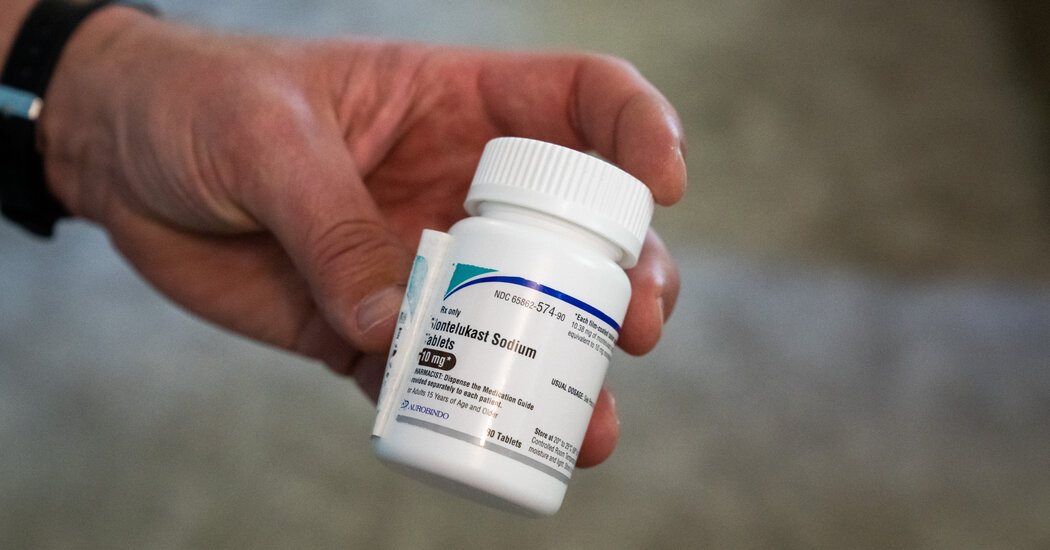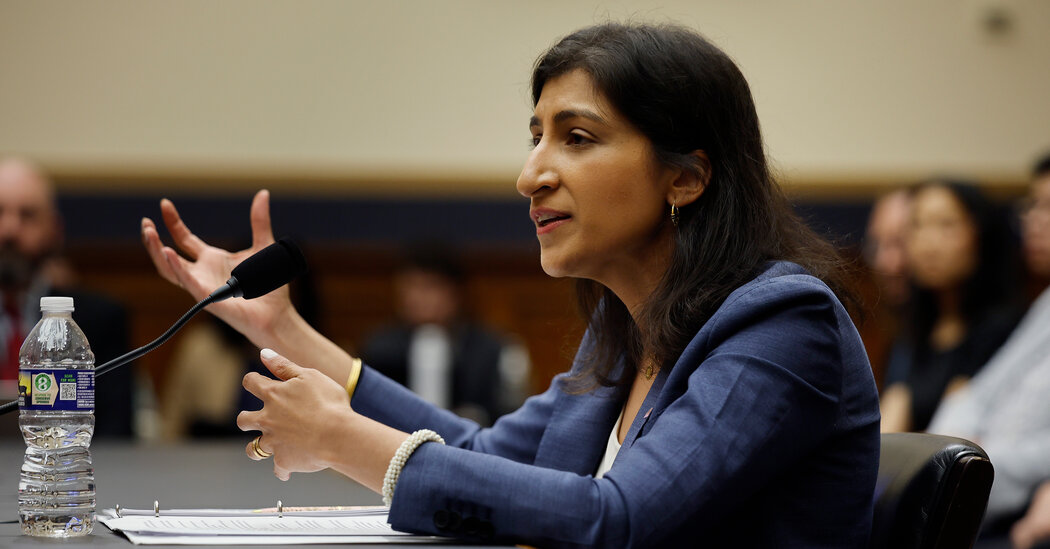In early 2020, the Food and Drug Administration responded to decades of escalating concerns about a commonly prescribed drug for asthma and allergies by deploying one of its most potent tools: a stark warning on the drug’s label that it could cause aggression, agitation and even suicidal thoughts.
The agency’s label, which was primarily aimed at doctors, was supposed to sound an alert about the 25-year-old medication, Singulair, also known by its generic name, montelukast. But it barely dented use: The drug was still prescribed to 12 million people in the United States in 2022.
Children face the greatest risks of the drug’s ill effects, and while usage by minors did decline, it was still taken by 1.6 million of them — including Nicole Sims’s son. Ms. Sims had no idea why, at 6, her son started having nightmares and hallucinations of a woman in the window. When he told her that he wanted to die, Ms. Sims went online, desperate for answers.
Only then did she learn about the F.D.A. warning. She also found a Facebook support group with 20,000 members for people who had experienced side effects of the drug. Members of the group recounted a haunting toll that they linked to the drug with the help of peers, not their doctors.
“It’s a mental health crisis that nobody is recognizing,” said Anna Maria Rosenberg, an administrator of the group.
The F.D.A.’s handling of Singulair illustrates systemic gaps in the agency’s approach to addressing troubling side effects from medicines approved long ago — and to warning the public and doctors when serious issues arise. The agency had flagged the 2020 warning label, known as a “boxed warning,” to physicians’ groups, but it had not required that doctors be educated about the drug’s side effects.
Federal regulators in 1998 initially dismissed evidence that emerged during the approval process about the drug’s potential to affect the brain and did not revise their assessment until two decades later. The F.D.A. was slow to alert the public as reports of psychiatric problems surfaced, highlighting deficiencies of a drug-monitoring system that puts the onus on drugmakers to report problems.
Federal regulators themselves can be blind to the full scale of a problem: The F.D.A. discovered nearly a decade ago that Merck, the maker of Singulair, received thousands more reports of side effects from the drug than the agency or its global counterpart. And after a teenager’s high-profile suicide in 2007, the F.D.A. stopped short of forcing Merck to conduct more rigorous and expensive studies that could have made clear how common bad reactions were.
Prescribing of the drug has remained at high levels, raising questions about whether the alert reached enough doctors and patients, who often don’t read the fine print on the drug’s tightly folded label, tucked into a bag at the pharmacy. (Prescribing data was provided to The New York Times by Komodo Health.)
Many doctors support the drug’s availability and see existing cautions as sufficient. But researchers have grown increasingly alarmed about its effects, especially on children, and about what they see as the F.D.A.’s failure to determine how many have been harmed or to get the word out to doctors.
“What are the great studies that tell us how often it happens? There aren’t any,” said Thomas Moore, of the Johns Hopkins Center for Drug Safety and Effectiveness, who has long tracked reports of montelukast’s psychiatric effects. “This is a structural problem.”
Dr. Reshma Ramachandran, a Yale University assistant professor and family doctor, said that the warning had not broken through to channels that doctors notice and that the agency “needs to do much more in terms of direct communication to clinicians and through more active channels.”
‘Searching for answers’
In issuing the warning in March 2020, the F.D.A. required pharmacists to hand out a medication guide and added the warning, with a thin black line as a border, to the drug label. The agency also sent a safety alert to email subscribers, flagged the warning to dozens of professional and patient groups, and published an article in a medical journal on its reasoning.
But it did not use its authority to require monitoring of side effects or the education of doctors. Rarely are approved drugs with known side effects fully barred from sale.
While researchers see evidence that points to a link between the drug and psychiatric side effects, studies vary significantly on how frequently they appear — or, in some cases, whether they appear at all. Reports include a wide range of psychiatric effects, making it challenging to pinpoint the cause.
The agency’s risk-benefit calculus for montelukast has weighed its psychiatric risks against its wide use in treating many patients for asthma, which can be deadly.
F.D.A. officials said they had taken appropriate action. In an interview, officials said that a number of compelling reports of psychiatric problems seemed drug-related and that the boxed warning was meant to raise awareness.
The agency is continuing to study notes in electronic health records for clues about side effects, and officials said it “continues to monitor and investigate this important issue.” But pinpointing the risks may not be feasible: It would take a large study to capture events such as suicides that remain rare, said Dr. Sally Seymour, director of the F.D.A.’s pulmonary drugs division.
With concerns lingering, researchers, including some at the F.D.A., have returned to basic animal studies to examine possible effects of montelukast in the brain, a quest that could take a decade to complete.
Merck, which reaped billions of dollars in revenue from the drug, spun it off in 2021 to the company Organon. Merck referred comment to Organon, but in an April 2023 court filing denied “a significant link between Singulair and neuropsychiatric events.”
Organon said in a statement that the company had communicated appropriate information to patients and health providers about the drug’s risks and benefits. “Nothing is more important to Organon than the safety of our medicines and the people who use them,” the company said. Other generic companies also sell the drug.
The warning was added before Ms. Sims’s son began talking about hearing scary voices and seeing walls that appeared to be melting. If she had known, she said, she would have stopped the drug right away.
Ashley Bracken also wishes her family’s allergy practice in Utah had alerted her to the boxed warning.
Ms. Bracken’s daughter, Genevieve, had been on the medication since age 7 and grew increasingly depressed after a doctor increased her dose to the adult level in April 2021, when she was 13. Her mother initially attributed her daughter’s obsessive hand washing to the pandemic. She wrote off her daughter’s moodiness to teenage angst.
Ms. Bracken said she first saw a list of the drug’s side effects, which include obsessive compulsive disorder, in a screenshot on Genevieve’s phone from October 2021.
She and her husband had been scouring the device for any clue to why the girl, then 14, had killed herself days before Christmas that year. The F.D.A.’s warning included suicide, though the agency has said no studies have definitively assessed the risk. The family’s medical practice declined an interview request.
“It sickened us,” Ms. Bracken said. “In the moment, we were searching for answers, because what she did didn’t make sense.”
Rising sales, growing concerns
Approved in 1998, Singulair soon became a top-selling drug. With a market of 25 million people battling asthma and more with allergies, sales representatives blanketed doctors’ offices. They promoted the drug as a once-a-day alternative to inhaled corticosteroids, which are considered more effective but also more cumbersome. Singulair came in a chewable, cherry-flavored pill for children.
Concerns surfaced within Merck: A whistle-blower claimed in a 2008 lawsuit that the company improperly paid doctors to prescribe drugs, including Singulair, and that the drug “leads to aggressiveness and attention deficit problems” in children. Merck settled the claims, largely related to other drugs, and admitted no wrongdoing.
Merck promoted the medication to parents, in 2009 partnering with the TV personality Jo Frost, known as “Supernanny” on reality television. Merck, which also made an inhaler for asthma, funded the American Academy of Pediatrics to train doctors about asthma diagnosis and prescribing, a Fox affiliate reported in 2010. (An NBC affiliate has also reported on problems with the drug.)
A worldwide success, the drug would earn Merck an estimated $50 billion in revenue, according to a recent Reuters analysis of the drug’s troubled history.
In 2007, its possible drawbacks drew wider attention when Elizabeth Little, a New York state senator, contacted the F.D.A. about a 15-year-old on Singulair who became hopeless and anxious, agency records show. The teenager killed himself 17 days after starting the drug.
Rather than mandating fresh studies of Singulair, the F.D.A. allowed Merck to review its existing trials. The company concluded in 2009 that those trials were not devised to identify psychiatric problems or suicides, and few had been noted. An F.D.A. examination of reports of side effects prompted Merck the same year to add warnings about hallucinations, hostility, anxiety and suicide to the label.
As of 2019, the F.D.A. had documented 82 suicides of people on montelukast. More than 500 suicide attempts have also been linked to the drug in unverified reports to the agency.
Problems drew notice worldwide. Researchers examining side effect reports sent to the World Health Organization in 2015 discovered outsize rates of anxiety and suicidal behavior among children on montelukast, a finding researchers deemed “striking” in young children.
A 2022 review of the same type of reports found high rates of aggression and agitation. Nightmares were reported 25 times as frequently as expected and suicidal thinking 18 times as frequently.
Such studies based on voluntary reports can identify problems, but not pinpoint how often they appear. Research trying to do so using more detailed health records is mixed. Studies of older adults and of U.S. veterans and an F.D.A. study on depression and suicide found few problems.
Some doctors cite those studies in arguing the F.D.A.’s warning in 2020 was sufficient. They said montelukast remained popular because it addressed asthma and allergies at the same time, with no side effects for some people. The drug eases breathing by suppressing inflammation in the airways.
“In some studies, they find increased risk, and in others, not,” said Dr. John Kelso, an allergist at the Scripps Clinic in San Diego.
Some reviews continue to find problems. A 2021 study of Korean health data found that older adults who had asthma and then developed psychiatric problems were 70 percent more likely to have taken montelukast-type drugs than those who had not. Younger adults in Denmark who were prescribed the drug were 38 percent more likely to soon need psychiatric or A.D.H.D. medications, a 2023 study found.
Even such “observational” reports can be biased by the unique features of people taking a drug, Mr. Moore, of Johns Hopkins, said.
Still, he said other evidence suggested the drug was causing the problems: They crop up in children with no psychiatric history. They go away when the drug is stopped. They tend to return if it’s restarted.
Settling the question of how common the problems are remains unlikely, said Dr. Daniel Benjamin, a Duke University researcher who helps distribute the scarce federal funds allocated to studying older pediatric drugs.
“There’s just a tsunami of drugs where we don’t really know what they’re doing in children,” he said.
Drug targeted at the airway goes into the brain
F.D.A. scrutiny of montelukast has brought new information to the fore and shed fresh light on older data.
In records approving the drug in 1998, the agency said only a “trace” amount of the drug crossed into the brain, though its data showed lingering levels in a rat’s brain 24 hours after a dose. That remained its stance for decades.
The agency reversed that conclusion in 2020. It cited a 2015 study — which highlighted the agency’s 25-year-old data — saying it showed “significant” penetration of the blood-brain barrier in rats. The agency concluded anew that “montelukast could act directly on cells in the brain” in rats and updated the drug label in 2020.
The F.D.A. has also struggled to get a handle on how many patients experienced harm.
In 2014, as Merck unsuccessfully sought approval to sell Singulair over the counter, F.D.A. records for an oversight meeting showed that Merck had data on about 46,500 cases with adverse events. U.S. officials and the World Health Organization knew about only 14,000.
Though Merck was not required to report nonserious side effects or those listed on the label from outside the United States, the agency noted that the tally from regulators was “still far lower” than Merck’s.
The breadth of problems remained urgent for leaders of the Facebook group, which in 2017 urged the F.D.A. to consider a boxed warning. That led to an emotional hearing in 2019.
A Massachusetts mother testified that when her 12-year-old daughter’s dose was raised, she began to hear voices telling her to harm herself; she dreamed about people being tortured and decapitated.
A Wisconsin mother said her son, 11, dreamed about his family being murdered. An Arizona mother said her 7-year-old developed severe tics, a problem one French study has tied to the drug.
Months later, the F.D.A. announced the boxed warning and began studies of the drug’s interactions with the brain.
‘Leave this Drug to Adults’
Other scientists, too, have been examining the effect of the drug on the central nervous system and its potential to accumulate in the brain.
One Swedish study found that mice taking the drug for two weeks had impaired cell growth in the hippocampus, a brain region critical for memory and learning. A 2022 study in Portugal found altered levels of dopamine and serotonin in rats, as well as lowered defenses against stress, said Gonçalo Justino, a biochemistry researcher at the University of Lisbon.
Dr. Justino said he was haunted by numerous case studies in the medical literature of distressed children. Given the degree of harm to some children, he said, doctors should “leave this drug to adults.”
Dr. Marc Flajolet, a Rockefeller University neuroscientist, said evidence suggesting that the drug could affect developing brains meant that “it will be probably safer at this point not to use that in kids until we know more.”
Other researchers have examined the drug’s interaction with genes or discussed its potential to release toxins or accumulate in the brain, especially in children.
Parents of children who’ve struggled on the drug urge caution.
In Tennessee, Ms. Sims’s son, now 8, has been off the drug for nearly two years. His drawings of red-eyed demons gave way to sketches of a smiling boy fishing under the sun.
Ms. Sims still worries about signs of lingering depression. After what seem to be great days, he will comment, “It wasn’t fun.” Few studies examine whether there are long-term effects.
Ms. Bracken said she and her husband learned more about their daughter’s mental state after her death. Her suicide note referred to “loud voices.” Texts to friends mentioned nightmares.
Ms. Bracken said she would like to see prescribing curtailed among children and, if it continues, mandatory communication about the risks.
“Who does it fall on?” she asked. “Why is it me, after losing my daughter, that I feel the need to go and put a PowerPoint together and present this to doctors to save lives?”
Audio produced by Adrienne Hurst.







